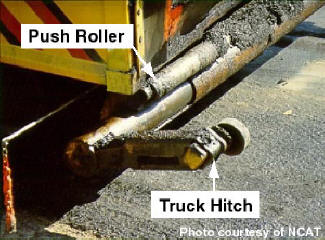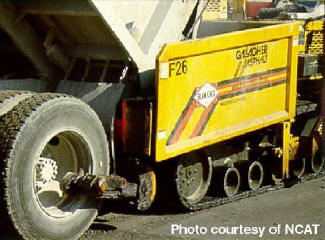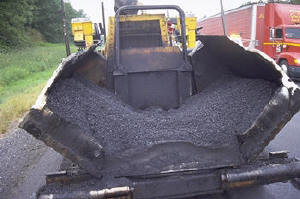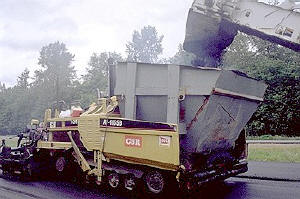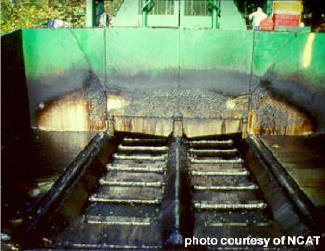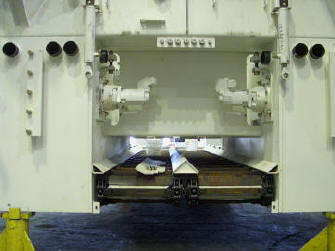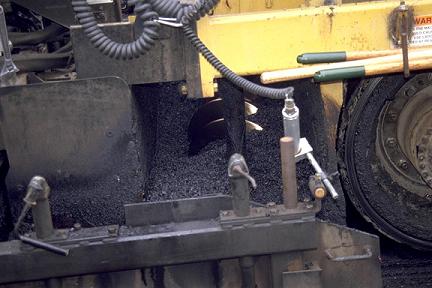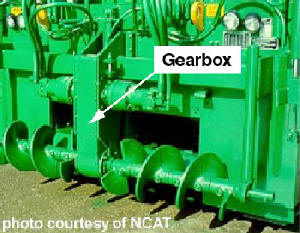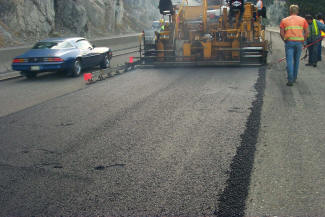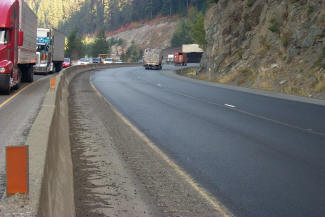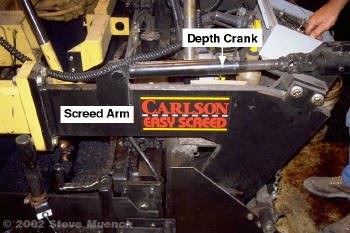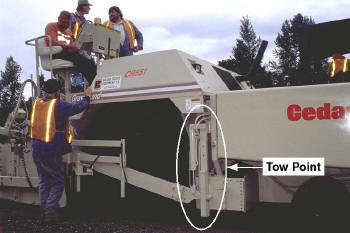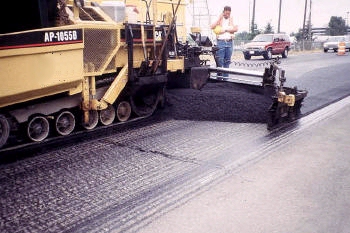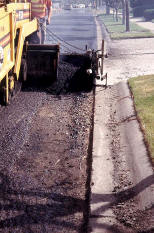In 1934 Barber-Greene introduced the Model 79 asphalt laydown machine, a self-propelled formless laydown machine with a floating screed (Tunnicliff, Beaty and Holt, 1974[1]). Since then, the basic concept of the asphalt paver has remained relatively unchanged: HMA is loaded in the front, carried to the rear by a set of flight feeders (conveyor belts), spread out by a set of augers, then leveled and compacted by a screed. This set of functions can be divided into two main systems:
- The tractor
- The screed
Tractor (Material Feed System)
The tractor contains the material feed system, which accepts the HMA at the front of the paver, moves it to the rear and spreads it out to the desired width in preparation for screed leveling and compaction. The basic tractor components are:
- Push Roller and Truck Hitch. The push roller is the portion of the paver that contacts the transport vehicle and the truck hitch holds the transport vehicle in contact with the paver (Figures 1 and 2). They are located on the front of the hopper.
- Hopper. The hopper is used as a temporary storage area for HMA delivered by the transport vehicle. Therefore, the paver can accept more material than is immediately needed and can use the volume in the hopper to compensate for fluctuating material demands created by such things as paving over irregular grades, utility access openings or irregular intersection shapes. Hopper sides (or “wings”) can be tilted up (or “folded”) to force material to the middle where it is carried to the rear by the conveyor system (see Figure 3). Hoppers can also be fit with inserts to allow them to carry more HMA (see Figure 4). These inserts are typically used in conjunction with a MTV.
- Conveyor. The conveyor mechanism carries the HMA from the hopper, under the chassis and engine, then to the augers (Figure 5 and 6). The amount of HMA carried back by the conveyors is regulated by either variable speed conveyors and augers or flow gates, which can be raised or lowered by the operator or, more often, by an automatic feed control system.
- Auger. The auger receives HMA from the conveyor and spreads it out evenly over the width to be paved (Figure 7). There is one auger for each side of the paver and they can be operated independently. Some pavers allow the augers to be operated in reverse direction so that one can be operated forward and the other in reverse to send all the received HMA to one side of the paver. The auger gearbox can either be located in the middle (between the augers as shown in Figure 8) or on the outside edge of each auger. If an inadequate amount of HMA is distributed under a middle-located gearbox the result can be a thin longitudinal strip of mat aligned with the gearbox that exhibits lower densities from aggregate segregation and/or temperature differentials (Figures 9 and 10).
Operation of the tractor, and specifically the material feed system, can have significant effects on overall construction quality and thus long-term pavement performance. Although there are many detailed operational concerns, the two broad statements below encompass most of the detailed concerns:
- HMA must be delivered to maintain a relatively constant head of material in front of the screed. This involves maintaining a minimum amount of HMA in the hopper, regulating HMA feed rate by controlling conveyor/auger speed and flow gate openings (if present), and maintaining a constant paving speed. As the next section will discuss, a fluctuating HMA head in front of the screed will affect the screed angle of attack and produce bumps and waves in the finished mat.
- The hopper should never be allowed to empty during paving. This results in the leftover cold, large aggregate in the hopper sliding onto the conveyor in a concentrated mass and then being placed on the mat without mixing with any hot or fine aggregate. This can produce aggregate segregation or temperature differentials, which will cause isolated low mat densities. If there are no transport vehicles immediately available to refill the hopper it is better to stop the paving machine than to continue operating and empty the hopper (TRB, 2000[2]).
Screed
The most critical feature of the paver is the self-leveling screed unit, which determines the profile of the HMA being placed (Roberts et al., 1996[3]). The screed takes the head of HMA from the material delivery system, strikes it off at the correct thickness and provides initial mat compaction. This section describes:
- Screed terminology
- The basic forces acting on the screed
- Screed factors affecting mat thickness and smoothness
- Automatic screed control
- Screed operation summary
Screed Terminology
The following is a list of basic screed components and terms (Figure 13):
- Screed plate. The flat bottom portion of the screed assembly that flattens and compresses the HMA.
- Screed angle (angle of attack). The angle the screed makes with the ground surface.
- Strike-off plate. The vertical plate just above the leading edge of the screed used to strike off excess HMA and protect the screed’s leading edge from excessive wear.
- Screed arms. Long beams that attach the screed to the tractor unit (Figure 11).
- Tow point. Point at which the screed arm is attached to the tractor unit (Figure 12).
- Depth crank. The manual control device used to set screed angle and ultimately, mat thickness (Figure 11).
- Screed heater. Heaters used to preheat the screed to HMA temperature. HMA may stick to a cold screed and cause mat tearing. After the screed has been in contact with the HMA for a short while (usually about 10 minutes) its temperature can be maintained by the HMA passing beneath it and the heater can be turned off. If the screed is removed from contact with HMA for an extended period of time, it may need to be pre-heated again before resuming paving.
- Screed vibrator. Device located within the screed used to increase the screed’s compactive effort. Screed compaction depends upon screed weight, vibration frequency and vibration amplitude.
- Screed extensions. Fixed or adjustable additions to the screed to make it longer (see Figures 13 and 14). Basic screed widths are between 2.4 m (8 ft.) and 3.0 m (10 ft.). However, often it is economical to use wider screeds or adjustable width screeds. Therefore, several manufacturers offer rigid extensions that can be attached to a basic screed or hydraulically extendable screeds that can be adjusted on the fly.
Screed Forces
There are six basic forces (Figure 15) acting on the screed that determine its position and angle (Roberts et al., 1996[3]):
- Towing force. This is provided by the tractor and exerted at the tow point. Thus, towing force is controlled by paver speed.
- Force from the HMA head resisting the towing force. This is provided by the HMA in front of the screed and is controlled by the material feed rate and HMA characteristics.
- Weight of the screed acting vertically downward. This is obviously controlled by screed weight.
- Resistive upward vertical force from the material being compacted under the screed. This is also a function of HMA characteristics and screed weight.
- Additional downward force applied by the screed’s tamping bars or vibrators. This is controlled by vibratory amplitude and frequency or tamping bar force.
- Frictional force between the screed and the HMA under the screed. his is controlled by HMA and screed characteristics.
Factors Affecting Mat Thickness and Smoothness
Since the screed is free floating it will slide across the HMA at an angle and height that will place these six forces in equilibrium. When any one of these forces is changed, the screed angle and elevation will change (which will change the mat thickness) to bring these forces back into equilibrium. Therefore, changing anything on the paver that affects these forces (such as paver speed, material feed rate or screed tow point) will affect mat thickness. Furthermore, since mat thickness needs to be closely controlled, pavers have controls to manually set screed angle rather than rely on a natural equilibrium to determine mat thickness. In typical paving operations the screed angle is adjusted to control mat thickness. In order to understand how a manually controlled screed angle affects mat thickness, a brief discussion of how the paver parameters of speed, material feed rate and tow point elevation affect screed angle, screed height and therefore mat thickness is provided.
Speed
Paver speed affects mat thickness by changing the screed angle. If a paver speeds up and all other forces on the screed remain constant, the screed angle decreases to restore equilibrium, which decreases mat thickness. Similarly, as paver speed decreases, screed angle increases, which increases mat thickness.
Material Feed Rate
The amount of HMA in front of the screed (the material “head”) can also affect screed angle and thus mat thickness. If the material head increases (either due to an increase in material feed rate or a reduction in paver speed), screed angle will increase to restore equilibrium, which increases mat thickness. Similarly, if the material head decreases (either due to a decrease in material feed rate or an increase in paver speed), screed angle will decrease to restore equilibrium, which decreases mat thickness (TRB, 2000[2]).
Therefore, in order to maintain a constant mat thickness for a change in paver speed or material head in front of the screed, the natural equilibrium of forces on the screed cannot be relied upon and the screed angle must be manually adjusted using a thickness control screw or depth crank. Screed angle adjustments do not immediately change mat thickness but rather require a finite amount of time and tow distance to take effect. Figure 16 shows that it typically takes five tow lengths (the length between the tow point and the screed) after a desired level is input for a screed to arrive at the new level.
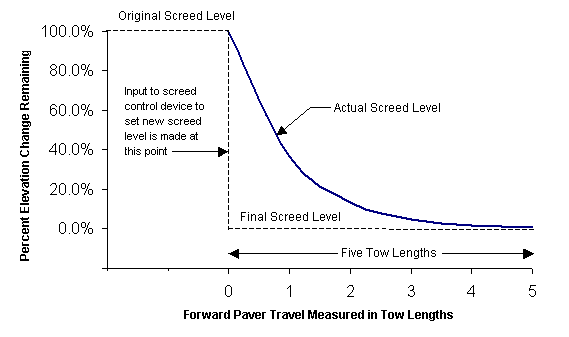
Because of this screed reaction time, a screed operator who constantly adjusts screed level to produce a desired mat thickness will actually produce an excessively wavy, unsmooth pavement.
Tow Point Elevation
Finally, tow point elevation will affect screed angle and thus mat thickness. As a rule-of-thumb, a 25 mm (1-inch) movement in tow point elevation translates to about a 3 mm (0.125 inch) movement in the screed’s leading edge. Without automatic screed control, tow point elevation will change as tractor elevation changes. Tractor elevation typically changes due to roughness in the surface over which it drives. As the tow point rises in elevation, the screed angle increases, resulting in a thicker mat. Similarly, as the tow point lowers in elevation, the screed angle decreases, resulting in a thinner mat. Locating the screed tow point near the middle of the tractor significantly reduces the transmission of small elevation changes in the front and rear of the tractor to the screed. Moreover, because the screed elevation responds slowly to changes in screed angle, the paver naturally places a thinner mat over high points in the existing surface and a thicker mat over low points in the existing surface (TRB, 2000[2]).
The interaction of paver speed, material feed rate and tow point elevation determine the screed position without the need for direct manual input. This is why screeds are sometimes referred to as “floating” screeds.
Automatic Screed Control
As discussed previously, the screed angle can be manipulated manually to control mat thickness. However, tow point elevation is not practical to manually control. Therefore, pavers usually operate using an automatic screed control, which controls tow point elevation using a reference other than the tractor body. Since these references assist in controlling HMA pavement grade, they are called “grade reference systems” and are listed below (Roberts et al., 1996[3]):
- Erected stringline. This consists of stringline erected to specified elevations that are independent of existing ground elevation. Most often this is done using a survey crew and a detailed elevation/grade plan. Although the stringline method provides the correct elevation (to within surveying and erecting tolerances), stringlines are fragile and easily broken, knocked over or inadvertently misaligned. Lasers can be used to overcome the difficulties associated with stringlines because they do not require any fragile material near the pavement construction area. Lasers can establish multiple elevation or grade planes even in dusty or high-electronic and light-noise areas and are therefore sometimes used to construct near-constant elevation airport runways. The laser method becomes quite complicated, however, when frequent pavement grade changes are required.
- Mobile reference. This consists of a reference system that travels with the paver such as a long beam or tube attached to the paver (called a “contact” device since it actually touches the road – see Figure 17) or an ultrasonic device (called a “non-contact” device since it relies on ultrasonic pulses and not physical contact to determine road elevation). The mobile reference system averages the effect of deviations in the existing pavement surface over a distance greater that the wheelbase of the tractor unit. Minimum ski length for a contact device is normally about 7.5 m (25 ft.) with a typical ski lengths being on the order of 12 to 18 m (40 to 60 ft.) (Asphalt Institute, 2001[4]).
- Joint matching shoe. This usually consists of a small shoe or ski attached to the paver that slides on an existing surface (such as a curb) near the paver. Ultra sonic sensors accomplish the same task without touching the existing surface by using sound pulses to determine elevation. This type of grade control results in the paver duplicating the reference surface on which the shoe or ski is placed or ultra sonic sensor is aimed.
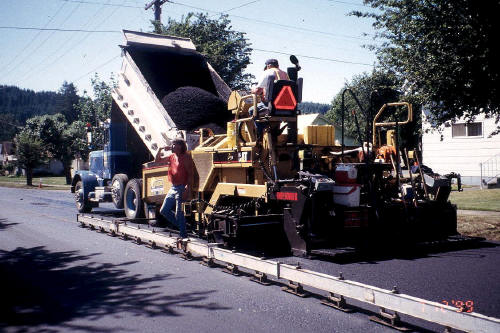
In addition to grade control, the screed can also be set to control pavement slope and/or crown. A slope controller uses a slope sensor mounted on a transverse beam attached to the screed to determine screed slope, then adjusts screed slope to the desired amount. Generally, one side of the screed is set up to control grade and the opposite side is set up to control slope based on that grade. The usual practice is to run grade control on the side of the screed nearest the pavement centerline and run slope control on the screed side nearest the pavement edge because it is easier to match the centerline joint if grade control is used on that side of the paver (TRB, 2000[2]).
Screed crown (the elevation of the middle in relation to the edges) can also be controlled. Typically screeds offer separate front and rear crown controls. If crown control is used, the front control is usually set to a slightly more severe crown than the rear control to allow for easier passage of HMA under the screed.
Screed Operation Summary
The floating screeds used by today’s pavers are acted upon by six basic forces, which when left undisturbed result in an equilibrium screed angle and elevation that determines mat thickness. Adjusting paver speed, material feed rate or tow point elevation will change these forces and result in a new equilibrium screed angle and elevation and eventually a new mat thickness. In order to achieve the most consistent thickness and smoothest possible surface, pavers attempt to maintain a constant speed, use automatic feed controls to maintain a consistent head of material in front of the paver, and use automatic screed control to maintain a consistent tow point. Although the screed angle can be adjusted manually to change mat thickness, excessive adjustments will result in a wavy, unsmooth mat. In addition to grade, screeds can also control mat slope and crown to provide almost complete control over mat elevation at any location.
- Tunnicliff. D.G.; Beaty, R.W. and Holt, E.H. (1974). A History of Plants, Equipment and Methods in Bituminous Paving. Asphalt Paving Technology: Proceedings, vol. 43A. Association of Asphalt Paving Technologists Historical Session., 26 February 1974. Williamsburg, VA. pp. 159-296.↵
- Transportation Research Board (TRB). (2000). Hot-Mix Asphalt Paving Handbook 2000. Transportation Research Board, National Research Council. Washington, D.C.↵
- Roberts, F.L., Kandhal, P.S., Brown, E.R., Lee, D.Y., and Kennedy, T.W. (1996). Hot Mix Asphalt Materials, Mixture Design, and Construction. National Asphalt Paving Association Education Foundation. Lanham, MD. ↵
- Asphalt Institute. (2001). HMA Construction. Manual Series No. 22 (MS-22). Asphalt Institute. Lexington, KY.↵

